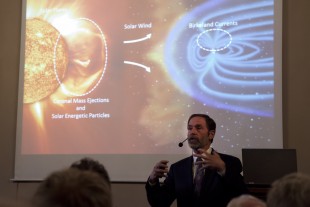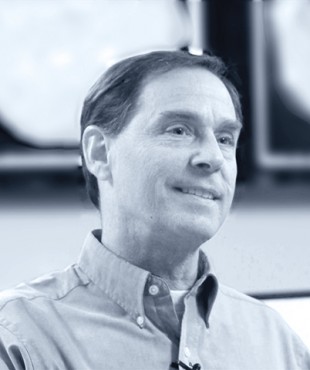
Our Connection to Space
Dr. Terry Onsager, National Oceanic and Atmospheric Administration, USA/Space Weather Prediction Center, USA, er årets Birkelandforeleser. Han skal snakke om "Our Connection to Space".
Birkeland: forskning, innovasjon og pris
I 2012 ble det innført en ekstraforelesning før selve Birkelandforelesningen der temaet skal være forskning og utvikling, altså helt i Kristian Birkelands ånd. I år ble denne forelesningen holdt av Sverre Bisgaard, Norspace. Hans forelesning hadde tittelen "SAW Technology - from Science to Industry".
I forbindelse med Birkelandforelesningen blir Yaras Birkelandpris delt ut. Prisen går til en PhD-kandidat fra et norsk universitet og utdeles annethvert år i fysikk og kjemi. I år går prisen på 100.000 kroner til en kjemiker, Dr. Pei Cheng Chua.
Som 17-åring campingturist i Narvik fikk han oppleve nordlyset for første gang. Kanskje ble det til inspirasjon for hans fremtidige yrkesvalg? Onsager er i dag tilknyttet Space Weather Prediction Center i Boulder, Colorado og direktør for International Space Environment Service.
Om foredraget: Our Connection to Space
Human civilization’s connection to space has evolved profoundly over the past centuries and millennia. For thousands of years our ancestors viewed the aurora and sunspots and acted upon beliefs of messages hidden in these heavenly signs. With the development of sophisticated instruments and the discovery of physical laws, a new era of understanding emerged. People found themselves connected to a vast, natural laboratory, able to measure directly eruptions on the Sun and energetic particles from throughout the galaxy.
It was within this era of understanding that Kristian Birkeland accomplished his pioneering work. Among his many discoveries was the profound and direct connection between Earth and space through the flow of electrical currents. The century since Birkeland’s discoveries has shown remarkable advances in our ability to observe, to understand, and ultimately to predict the complex physical processes linking Earth to space.
Most recently, the development of modern technology and the global integration of our economic and security infrastructures have connected our daily lives to space in ways previously unimaginable. The electric power grid, air and space travel, satellite operations, and the ubiquitous global navigation systems are all impacted by the dynamics of the space environment, collectively referred to as “space weather.” We are now faced with the challenging imperative to reach beyond our scientific understanding and apply our knowledge, both to safeguard our modern infrastructure and to enable future exploration and utilization of space.
The modern challenge introduced by our growing connection to space now requires a new level of coordination around the globe. Efforts are underway within national governments, private industry, and United Nations organizations to advance our research, coordinate our observing and service networks, and develop civil contingency plans for the possibility of extreme space weather events. Although still at an early stage, exciting progress is being made to build on scientific achievements and to develop the necessary prediction and alerting capabilities. This will ultimately lead to a more effective utilization of space and stronger connections here on Earth.
Dr. TERRANCE ONSAGER
National Oceanic and Atmospheric Administration (NOAA)
Space Weather Prediction Center, USA
Dr. Onsager is a physicist at the Space Weather Prediction Center in Boulder, Colorado and Director of the International Space Environment Service.
Terry Onsager first viewed the aurora while camping in Narvik, Norway at age 17. He subsequently received his Ph.D. in Physics at the University of Washington and conducted research at Los Alamos National Laboratory, the University of New Hampshire, the Institute for Space and Astronautical Science (Japan), and Nagoya University. He joined the Space Weather Prediction Center in 1995.
His education and research career concentrated first on fundamental topics of solar-terrestrial physics and more recently on applying our knowledge of Earth's space environment to address society's growing need for real-time space weather information. His career has spanned an exciting transition period during which numerical prediction models of the Sun-Earth system have matured, space-based and ground-based observations have multiplied, and the demand for timely and accurate information on solar eruptions and their consequences has expanded.
As Director of the International Space Environment Services, he leads the coordination of a global network of space weather service-providing organizations. Currently 16 centers around the world provide a range of services, including forecasts, warnings and alerts of solar, magnetospheric, and ionospheric conditions. In addition, he co-chairs the World Meteorological Organization's Inter-Progamme Coordination Team on Space Weather, and he served as a member of the Space Weather Expert Group for the United Nations Committee on the Peaceful Uses of Outer Space Long-Term Sustainability of Outer Space Activities.
